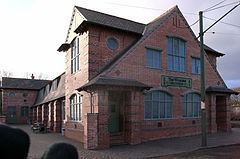Status Preserved Completed 1912 (1912) Architect A. T. Butler | Type Workers' Institute Opened 1912 Groundbreaking 1911 | |
 | ||
Similar Black Country Living Mu, Dudley Canal, Birmingham Canal Navigations | ||
The Cradley Heath Workers' Institute was built between 1911 and 1912 in Lomey Town, Cradley Heath, West Midlands, England. It was built as a social centre for the Black Country, intended to become a venue for educational meetings and lectures. It also housed Union offices, where members could come to seek guidance, and from which the Contributory Unemployment Fund would be distributed. In 2006 the building was threatened by a bypass and so was moved to the Black Country Living Museum.
Contents
Map of Cradley Heath Workers' Institute, Dudley, UK
Design and construction
The Institute's architect was local man A T Butler. With its projected gables, leaded windows, exposed brickwork and signage in green tiles, the building is a demonstration of Arts and Crafts style.
History
Construction of the Institute was funded using money left over from the strike fund of the 1910 women chainmakers' strike, led by Mary Macarthur.
Between 1915 and 1933 it largely functioned as a cinema. It was then used as a billiards hall until 1950, after which it became postal sorting office until 1995. It was moved to the Black Country Living Museum in 2006 after a bypass threatened the site. It now contains period offices, which are demonstrated by Museum staff, and an exhibition about Mary Macarthur. The original auditorium houses a café for the museum and the stage is used for special events.
